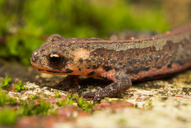|
Ommatotriton ophryticus (Berthold, 1846)
Northern Banded Newt | family: Salamandridae subfamily: Pleurodelinae genus: Ommatotriton |
| Species Description: Litvinchuk, S.N., Zuiderwijk, A., Borkin, L.J., Rosanov, J.M. 2005. Taxonomic status of Triturus vittatus (Amphibia: Salamandridae) in western Turkey: trunk vertebrae count, genome size and allozyme data. Amphibia-Reptile 26: 305-323. | |
 © 2015 Henk Wallays (1 of 55) |
|
|
|
Description Distribution and Habitat Country distribution from AmphibiaWeb's database: Armenia, Georgia, Russian Federation, Turkey
The newt lives generally higher than 1200 m above sea level, mainly in coniferous, mixed and deciduous forests up to subalpine meadows. The terrestrial habitat may be quite arid, especially in the Mediterranean part of the species range. Life History, Abundance, Activity, and Special Behaviors The daily activity pattern in T. vittatus is similar to that of other Triturus species. Hibernation generally occurs on land. However, males and females with nuptial coloration were found at the beginning of January in a spring (Krasnodar Region in the North Caucasus). In the Caucasus, the newts come to hibernacula in September - October. Hibernation ends in February - March at low elevations, and in April-May in the highlands. The breeding period extends from late February to July, depending on weather and altitude. In highland populations it may extend to the end of July. In warm years the newts living at low elevations remain active throughout the year. In the southern Mediterranean part of the range, where summer is dry, the seasonal activity is shifted to the wet and warm winter period, and the adults may leave the water even in February. The males are territorial, even more territorial than other European newts of the genus Triturus. Spawning is preceded by courtship, in general similar to that of the Smooth Newt (Triturus vulgaris). Clutch contains 59-240 eggs deposited singly or in short chains. The eggs are deposited in portions of 1-53 eggs per day at 2-11 day intervals. Embryogenesis takes 12-30 days, and metamorphosis is completed after 70-150 days. In a few mountain ponds some larvae (i.e. those hatched from the last clutches) hibernate and finish their transformation the following year. Sexual maturity is attained at 3 - 5 years; maximum longevity was estimated as 8 - 21 years. After transition to active feeding, T. vittatus larvae eat microcrustaceans. Their prey spectrum later expands because of increasing numbers of molluscs and insects. Recently metamorphosed juveniles consume only terrestrial prey such as Collembola, Aphidinea, larval Hydrophilidae, Chrysomelidae and Diptera. Like other newt species during the aquatic phase, adult newts prey mainly on aquatic molluscs, crustaceans and insects. During the aquatic phase, adult T. vittatus often eat amphibian larvae. Cannibalism at nesting sites in the form of oophagy appears to be widespread, especially among females, which come into contact with recently deposited eggs more often than males. Many invertebrates and vertebrates, including some species of amphibians, are known as natural enemies of this newt. Trends and Threats Although this is a more common species than other syntopic newts in some localities of the Caucasus, it should be considered as generally rare for relevant regions. Relation to Humans Comments
References
Bannikov, A. G., Darevsky, I. S. and Rustamov, A. K. (1971). Zemnovodnye i Presmykayushchienya SSSR [Amphibians and Reptiles of the USSR]. Izdatelistvo Misl, Moscow. Bannikov, A. G., Darevsky, I. S., Ishchenko, V. G., Rustamov, A. K., and Szczerbak, N. N. (1977). Opredelitel Zemnovodnykh i Presmykayushchikhsya Fauny SSSR [Guide to Amphibians and Reptiles of the USSR Fauna]. Prosveshchenie, Moscow. Basoglu, M. and Ozeti, N. (1973). Turkiye Amphibileri. Ege Univ, Bornova-Izmir. Gasc, J. P. , Cabela, A., Crnobrnja-Isailovic, J., Dolmen, D., Grossenbacher,K., Haffner, P., Lescure, J., Martens, H., Martinez Rica, J. P.,Maurin, H., Oliveira, M. E., Sofianidou, T. S., Vaith, M., and Zuiderwijk, A. (1997). Atlas of Amphibians and Reptiles in Europe. Societas Europaea Herpetologica and Muséum National d’Histoire Naturelle, Paris. Griffiths, R.A. (1996). Newts and Salamanders of Europe. T. and A. D. Poyser, London. Kuzmin, S. L. (1995). Die Amphibien Russlands und angrenzender Gebiete. Westarp Wissenschaften, Magdeburg. Kuzmin, S. L. (1999). The Amphibians of the Former Soviet Union. Pensoft, Sofia-Moscow. Nikolsky, A. M (1936). Fauna of Russia and Adjacent Countries: Amphibians (English translation of Nikolsky, 1918, Faune de la Russie et des Pays limitrophes. Amphibiens. Académie Russe des Sciences, Petrograd, USSR). Israel Program for Scientific Translations, Jerusalem. Nikolsky, A. M. (1906). Herpetologia Rossica. Mémoires de l'Académie Impériale des Sciences de St.-Pétersbourg, Série 8, Phys.-Math, Vol. 17, Sofia, Moscow. Tarkhnishvili, D. N. and Gokhelashvili, R. K. (1999). ''The amphibians of the Caucasus.'' Advances in Amphibian Research in the Former Soviet Union, 4, 1-233. Terent'ev, P. V. and Chernov, S. A (1965). Key to Amphibians and Reptiles [of the USSR]. Israel Program for Scientific Translations, Jerusalem. Originally submitted by: Sergius L. Kuzmin (first posted 2005-10-26) Edited by: Sean Schoville (1/18/00), D. B. Wake (10/26/05) (2021-01-26) Species Account Citation: AmphibiaWeb 2021 Ommatotriton ophryticus: Northern Banded Newt <https://amphibiaweb.org/species/6655> University of California, Berkeley, CA, USA. Accessed Mar 28, 2025.
Feedback or comments about this page.
Citation: AmphibiaWeb. 2025. <https://amphibiaweb.org> University of California, Berkeley, CA, USA. Accessed 28 Mar 2025. AmphibiaWeb's policy on data use. |



 Raffaëlli Account
Raffaëlli Account Map of Life
Map of Life